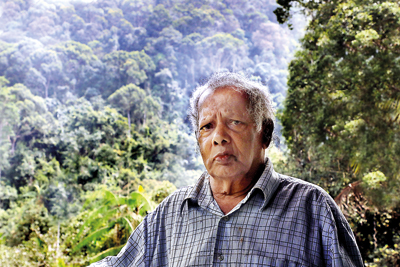A life as rich as the forest he lives for

Nowhere else he’d rather be: Martin at Sinharaja. Pic by M.A. Pushpa Kumara
Flocks of the Ceylon Magpie- born drama queens- are the first to greet the visitor to Sinharaja at its dark shady northern entrance at Kudawa. Condescendingly soaring down from the high canopy- their eternal home- they squabble like chirpy debutantes- flashing exotic plumage.
That morning however, the histrionics of the avian prima donnas were totally lost on us. We were on a trek to meet the “Professor of Sinharaja”- the guardian of the great rainforest who has been an icon of this wilderness- taking the lead in a crusade to preserve the dense wet ecosystem as lush and rich as any pristine rainforest in the world.
Martin Wijesinha, we found in his forest abode, a small lodge for naturalists- a shy man living a Spartan life who has been nonetheless a quietly pugnacious protector of Sinharaja- throughout its modern saga.
He was there to assist Thilo Hoffmann when the Swiss naturalist came up with his ‘Non-Technical Account’ of the Sinharaja in 1972. It was Martin who guided the scientific team through the lairs of the rare leopard and the magnificent ‘feeding flocks’ of birds, opening the eyes of the world to the lethal blow that logging- rampant at the time- could deal. He was probably as instrumental as Hoffmann in bringing the forest logging to a definite end by 1977.
Now closing in on his 80th birthday, falling this Christmas Eve, Martin can look back on a life as rich as the forest world he lives for.
Raised in Pethiyakande, probably the most farflung border village to fall under the Sinharaja’s shadow, Martin was heir to the jungle craft as his father, though a carpenter- cultivated chenas, tapped kitul flowers and went gathering into the Sinharaja ‘adaviya’- that once dark mysterious domain.
Martin was always the dreamer, the budding young poet besotted with nature. He says that as a youth he had rahu kaala (a bad astronomical period) where he was destined to roam and never settle.
Soon, however, he moved to Kudawa, at the northernmost edge of the forest, and got a job at the Forest Department- hardly tribute enough for a man with such heightened awareness of nature, but he made good of it. So began a mutual trade of knowledge that formulated a don out of humble Martin.
“All those people who came to Sinharaja were my gurus- just as I was a teacher for them.” The scientific erudition would be bartered for the rich native wisdom.
This began with the late Prof. S. Subramaniam, the botanist who taught him all about Latin terms and the rudiments of plant science and continued with Prof. Sarath Kotagama, Prof. Nimal Gunetilleke, Prof. Magdon Jayasuriya and Prof. Lakdas Fernando. Visitors would impart knowledge (a master from S. Thomas would teach him Latin) or give him the gifts he most treasures- books.
Sinharaja is, for Martin, an all-consuming passion. He knows all its recorded fauna and ‘99 percent’ of the plants. He also knows its history, its lore, and has many a tale to tell with a raconteur’s genius over a cuppa, including those of hunting ghostly sambhurs and arcane folktales.
The forest and its hinterlands were first populated by those fleeing the wrath of the Portuguese and the Dutch after devastating rebellions. Martin alone knows the old caves, giant jak trees and the primitive homes of those settlers in the wild.
The deity who has power over the adaviya is called ‘Kohomba’- a yakka who used to be propitiated with the first harvest and dance-drama rituals.
The name Sinharaja has always presumed a great Asiatic lion once roaring over a prehistoric kingdom- but no lions nor rhinos- nor even gaurs- were here. The Sinhale was the name for the virgin forest stretching from Matugama to Bibile, and ‘Sinhale raja kelewa’ (the royal forest of Sinhale) was contracted to Sinharaja.
The Sinharaja has remained pristine since life on earth appeared, assures Martin, citing as testators the antediluvian plants balal wanassa, pogonatum and the loamy bed in which come embedded age-old chronicles of Mollusca and ancient shells.
A species of gonala- an edible yam- unknown to science but an epicurean delicacy for the villager- today bears Martin’s name. He was also part of the National Conservation Review team who discovered a few hitherto unknown agamid lizards.
When Nihal Fernando (of Studio Times) was once chosen for a State Lifetime award, the Lankatilleke, he at once responded that Martin was much more deserving of the accolade, and so for once the State recognized this simple man. He took it as he took all bouquets and brickbats and- indeed- death threats- with equanimity.
But for the ardent nature lovers of the island, Martin Wijesinha will always be a legend — living testimony to how nature adorns the man who adores nature- a rare specimen of Homo sapiens with a huge heart and the gentlest soul- aroused into a lion only when his beloved Sinharaja is under threat. It is sad, as he says, that a lot of the secrets of our richest ecosystem, a World Heritage site, would have to go with him.


